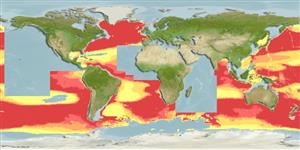>
Aulopiformes (Grinners) >
Alepisauridae (Lancetfishes)
Etymology: Alepisaurus: Greek, alepis, -idos = without scales + Greek, sauros = lizard (Ref. 45335).
Environment: milieu / climate zone / depth range / distribution range
पारिस्थितिकी
समुद्री बैथीपिलाजिक; गहराई सीमा 640 - 1591 m (Ref. 57178). Deep-water; 68°N - 72°S, 180°W - 180°E
Circumglobal.
आकार / वज़न / Age
Maturity: Lm ? range ? - ? cm
Max length : 96.0 cm TL पुल्लिंग / अलिंग; (Ref. 4059); common length : 70.0 cm TL पुल्लिंग / अलिंग; (Ref. 5217)
पृष्ठीय रीढ़ (सम्पूर्ण) : 0; पृष्ठीय सौफट रेज़ (सम्पूर्ण) : 40 - 48; गुदा कांटा: 0; ऐनल सौफट रेज़: 13 - 16. Iridescent brownish-black above, paler below; dorsal fin with horizontal row of white spots (Ref. 4059).
Feed on euphausiid shrimps and fishes. Edible but flesh is bland (Ref. 5217).
Life cycle and mating behavior
Maturities | पुनरुत्पत्ति | Spawnings | Egg(s) | Fecundities | लार्वा
Post, A., 1990. Alepisauridae. p. 387-388. In J.C. Quero, J.C. Hureau, C. Karrer, A. Post and L. Saldanha (eds.) Check-list of the fishes of the eastern tropical Atlantic (CLOFETA). JNICT, Lisbon; SEI, Paris; and UNESCO, Paris. Vol. 1. (Ref. 4476)
IUCN Red List Status (Ref. 130435)
Threat to humans
Harmless
Human uses
साधन
Special reports
Download XML
इंटरनेट स्रोत
Estimates based on models
Preferred temperature (Ref.
123201): 2.4 - 6.2, mean 4.8 °C (based on 881 cells).
Phylogenetic diversity index (Ref.
82804): PD
50 = 1.0000 [Uniqueness, from 0.5 = low to 2.0 = high].
Bayesian length-weight: a=0.00389 (0.00180 - 0.00842), b=3.12 (2.94 - 3.30), in cm total length, based on all LWR estimates for this body shape (Ref.
93245).
Trophic level (Ref.
69278): 3.8 ±0.61 se; based on food items.
Fishing Vulnerability (Ref.
59153): High vulnerability (58 of 100).
